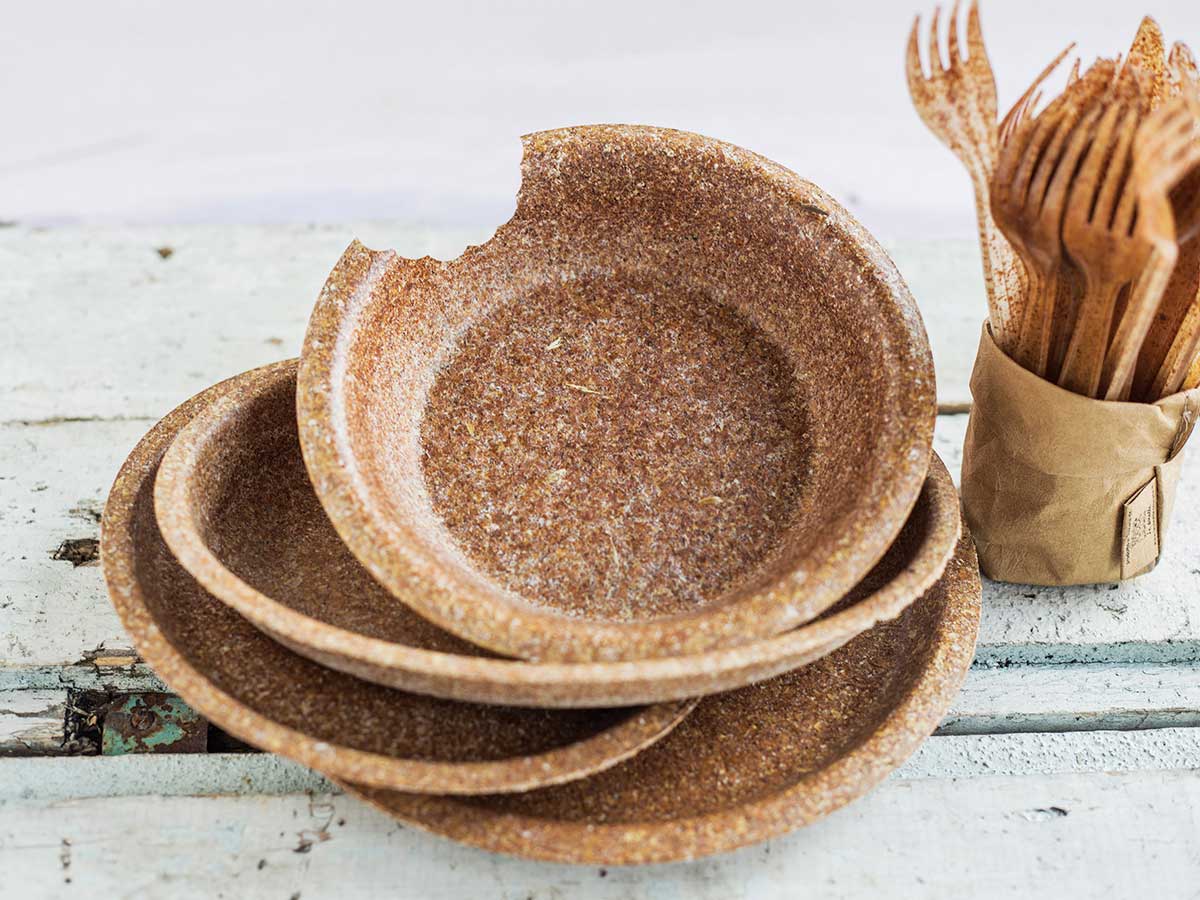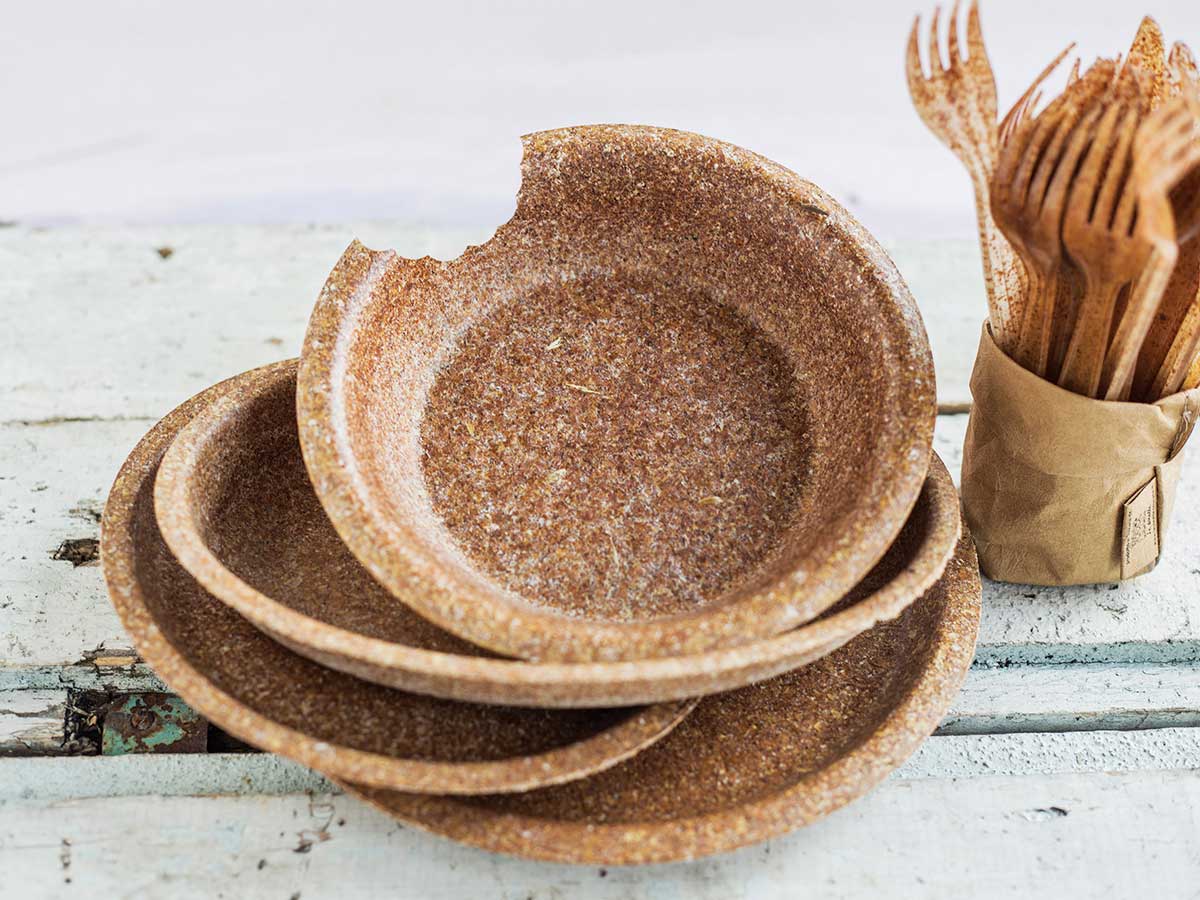
Why biodegradable plates and cutlery are replacing passé plastics
 Biotrem’s edible wheat bran plates (Photograph courtesy of Biotrem)
Biotrem’s edible wheat bran plates (Photograph courtesy of Biotrem)
When picnickers find themselves passing out paper plates this summer, there’s a good chance the forks they’ll have packed won’t be plastic. That’s because alternatives to single-use plastics such as cutlery and straws—which take a hundred or more years to decompose in a landfill—are at the forefront of a major shift in the market. And it’s consumers who are leading the push toward biodegradable varieties with a smaller environmental footprint.
The shift has been gaining momentum over the past 18 months, spurred in part by pictures and videos shared over social media depicting penguins living on islands of trash, divers swimming through a swamp of plastic near Bali, and a sea turtle bleeding as a six-inch plastic straw is extracted from its nostril. These images have helped fuel the “No Straw” movement, a campaign aimed at reducing the 500 million plastic straws used every day. In June, Canada announced it would ban single-use plastics as early as 2021.
Among forward-thinking business leaders, this is “an opportunity to do the right thing that [will] give their business a competitive advantage,” says Payments Canada CFO Pamela Steer, a sustainability expert and member of the Canadian chapter of the Accounting for Sustainability Leadership Network, which brings together leading CFOs to embed environmental and social issues into their businesses’ strategies and processes. (Steer was also named Canada’s CFO of the Year in April.) She says that economies of scale could eventually make sustainably sourced and degradable products less expensive than their landfill-loading alternatives. It hangs on taking what she describes as “a longer-term, bigger-picture view.”
One company giving that a try is Biotrem. The family of CEO Jerzy Wysocki farmed and milled wheat in rural Poland throughout the 20th century, but pressure from larger millers was threatening to sink the business. So today, Biotrem uses wheat bran, a byproduct of milling wheat, to manufacture plates, knives and forks that decompose in 30 days, compared to six months for paper or a century for plastic utensils. At roughly $30 for 100 plates, these edible alternatives to single-use plastics aren’t cheap—125 foam plates go for $6 at Walmart—but prices are likely to come down as production increases. Biotrem has spent millions on research and development with the aim of selling the internationally patented technology beyond Europe. Currently, the company generates 15 million plates and pieces of cutlery annually, sold throughout Europe, North America, South Korea and Lebanon.
Then there’s Bakeys in India, which since 2011 has been producing single-use cutlery from rice husks, flour and potato starch extracts. Company founder Narayana Peesapaty dove into the biodegradable cutlery market in response to India’s growing problem with single-use plastic utensils, an estimated 120 billion of which are used and thrown out in the country every year. In 2016, Bakeys went viral thanks to a video of its wares on Facebook. The following year, it sold 2.5 million edible forks in plain, sweet and savoury flavours in India alone. The company expects to increase sales to international clients as production ramps up. Shipping edible cutlery, however, poses a problem: It adds costs and can undermine the product’s green credentials (at Bakeys, forks are wrapped in Styrofoam to keep them from breaking).
New York-based VerTerra Dinnerware has been manufacturing cutlery, plates, cutting boards and bento boxes from dried fallen palm leaves since 2006. The sturdy tableware can withstand two minutes in the microwave or 45 minutes in the oven at 350 F without disintegrating. The company partners with the respected culinary heavyweight James Beard Foundation to supply goods for swanky catered events and has been winning sustainability and product awards since 2008. In an industrial composter, their products decompose in 60 days.
Mexico’s Scott Munguía was still a student when he founded Biofase, which makes its cutlery out of recycled avocado pits. (Insert millennial joke here.) Looking for something sweeter? Eat your ice cream with a hard candy spoon that Toronto company Candy Cutlery fashions out of cane sugar. They market it as a “second treat.”
It’s a whimsical alternative, but environmentally friendly cutlery is big business. Analysis from the U.K. information services firm IHS Markit suggests that the market value of biodegradable plastics had passed $1 billion by 2018 and could easily reach $1.7 billion by 2023. The food packaging and “disposable tableware” segments were the primary drivers of this surge in value.
Steer believes that government regulation could, one day, be used to help drag laggards toward greater sustainability. But that regulatory nudge may not be necessary if consumers continue to demand greener practices. Public pressure pushed McDonald’s, for example, to ditch Styrofoam food containers and polystyrene cups. Picnickers can protest, demanding forks and spoons that won’t outlive them by centuries. In the meantime, nothing’s stopping anyone from packing the reusable metal ones in their cutlery drawer.
THE LAST STRAW |
|---|
|
Canada and the European Union both plan to ban single-use plastics as early as 2021. Here are a few others going straw-less. Next time you see a plastic straw, just say, ‘No, I'm not falling fore your ruse, straw.’ ” — NFL quarterback Tom Brady, who posted an anti-straw video to Instagram last year “Everything can be served without a straw. It was just changing the mentality.” —Tofino restauranteur Samantha Hackett. The B.C. surf town banned plastic straws and bags in June “[This lid] is going to take billions of single-use plastic straws off the market.” —Starbucks packing director Andy Corlett on the coffee chain's new “sippy cup” lid |